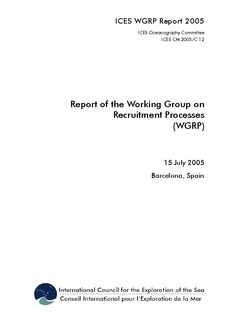| dc.description.abstract | The Working Group concentrated on the last Term of Reference and worked toward produc-ing a clear set of guidelines and objectives for the future. The meeting was the day after the International Larval Fish Conference (sponsored by the American Fisheries Society), this year in Barcelona. Both regular members of the WGRP and invites who had attended the confer-ence attended the meeting. The ToR was addressed with three presentations (R. D. M. Nash, IMR, Norway on the biological context in which the production of recruits occurs; T. J. Miller, CBL, USA reviewing the physical context in which recruitment occurs; and A. Folk-vord, U. Bergen, Norway reviewing the early life processes that result in the final observed level of recruitment) (Section 3). These presentations once again highlighted the point that recruitment had to be considered in more than a single step, as undertaken in traditional stock and recruit relationships and that studies and understanding need to consider the adults (pro-duction of offspring) through to the juveniles (at recruitment) and not just the early pelagic phases of the life cycle. There are also new tools available (e.g., Individual Based Models, genetic techniques etc) that mean recruitment processes studied that were not possible previ-ously can now be undertaken.
The presentations lead to formalisation of immediate and longer-term future goals and objec-tives for the Working Group (Section 4). The intention is for the work undertaken by the WG to result in both reports to ICES and manuscripts that can be submitted for publication in peer-reviewed scientific journals. The WG will review the contribution of coupled physical-biological models in regard to recruitment (4.1), examine selective processes that affect mor-tality in early life history (4.2), construct multi stage models of recruitment (4.3), examine the effects of stock structure, reproductive potential and recruitment on stock dynamics (4.4) and bring together experts in various fields of recruitment biology and ecology to debate the future directions for recruitment research (4.5).
Over the longer term it is the intention of the WG to approach other issues, namely environ-mental predictors of recruitment (4.6.1), synchronous and asynchronous recruitment in large marine ecosystems (4.6.2), the influence of recruitment events on community dynamics (4.6.3), and the effects of a changing global environment on recruitment processes (4.6.4).
The Working Group will co-sponsor (WGZE) a suggestion for a theme session (Predation on zooplankton and ichthyoplankton) at the 2006 ASC. | en |
